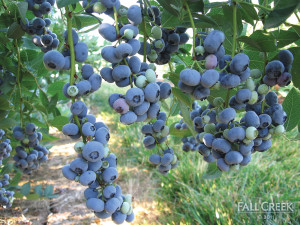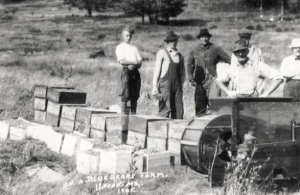I walked my way through rows and rows of neatly lined up bushes in the summer heat holding my green cardboard container, intensely looking at each one, pushing branches aside. I stopped and excitedly called over to my kids, “Here is a good one!” They came running over past the other people with their containers and said, “Oh look at them all.” This bush had lots of beautiful, plump, vibrant purple berries gathered together in clumps on each branch. I plucked the luscious, delicate blueberries off the branches with my purple stained fingers and dropped them into my basket, being careful not to squash any. I walked over to the next row and gently pulled some more off, breaking one in the process, causing the sweet juices to drip on my hands and add more stains. Finally, I looked down at my basket, which was now over flowing with freshly picked berries.
We walked over to the make shift wooden stand—big enough for 2 workers to fit behind, with nothing but a thin plywood roof to provide some shade, a small register, piles of containers for customers to use for picking, and a scale. I handed my berries over to the young girl to pay for them and headed home with my purple fingers to make some delicious treats.
This blueberry farm is one of many in RI where hundreds of people flock to during blueberry season (which only lasts for a very short few weeks in late July). Although blueberries are available all year round, this is when they are the most flavorful, vibrant and nutritious. And picking them yourself is a fun way to spend the day with the family. Blueberries have gotten a lot of media attention recently as being a super food, yet this is not something new. They have been around for many generations. So where did they originate and why are they so popular as being labeled a food you must eat?
First, some believe that wild blueberries date back to around 13,000 years, and it is the oldest plant in history according to James Bay wild fruit. Virgil and Pliny discovered this berry and the plant was named as “vaccinium” which comes from a Latin word Vaccinus, meaning cow. Not sure what the relation is, perhaps cows enjoyed this vibrant berry as well. Bears would only eat these berries and nothing else when they were in season and would travel long distances to find them. So if you like to grow blueberries, watch out for those bears who will steal them from your yards. They grow all around the world but are native to North America and are closely related to cranberries, azalea, and rhododendron. You may have even heard them called other nick names, such as cowberry, bilberry, farkleberry and sparkleberry.
Going back before the colonists, Native Americans believed they were sacred, due to the star shape on the ends, and that they were sent by the great spirits to relieve the hunger of their children. They enjoyed a pudding called “sautauthig” that was made by mixing honey, cornmeal and water. The juice was often used as a cough syrup, in teas, as a relaxant during childbirth, and as dyes for clothes. Early colonists discovered blueberries as a good source of food which was in short supply and when sugar was expensive. They were canned and shipped to civil war troops in the 1860’s during the war. Unlike the low bush variety that the Indians harvested, today’s blueberries are a domesticated high bush that typically covers an area 75 to 250 ft. There are a few varieties grown today that produce bigger blueberries, with more color and a different flavor, and that have a higher yield than their ancestors. And America is growing 90% of them in the world.
 Today, blueberries have been getting a lot of attention as being a superfood that is highly nutritious. It seems that the Indians knew this centuries ago, and that we are only rediscovering it now. These low in calorie berries pack the most antioxidants of any other fruit. Antioxidants help to fight free radicals that damage cells and cause cancer, and studies show they improve brain health and memory. They are packed with phytochemicals which are chemicals that plants produce in order to protect themselves against viruses and disease. Therefore when eaten, we also gain from these benefits. The blue color comes from a compound called Anthocyanins that has been known to block tumors and cancer cells from forming. They are a good source of vitamin c, soluble fiber, vitamin K,A & E that help the body to metabolize carbs proteins and fats, manganese, iron for red blood cell formation, zinc, and copper for red blood cell production. They are capable of reducing cholesterol and triglycerides. The chlorogenic acid also helps to lower blood sugar levels and control blood glucose and high potassium to help regulate blood pressure (Nutritionandyou.com, 2009). As you can see, they are truly a little blue berry that is a super food. So grab your baskets, buckets, bags, boxes, containers, empty paper coffee cups, Rubbermaid bins, or pick-up truck and go get those tasty powerhouse fruits that are only in season for a short time.
Today, blueberries have been getting a lot of attention as being a superfood that is highly nutritious. It seems that the Indians knew this centuries ago, and that we are only rediscovering it now. These low in calorie berries pack the most antioxidants of any other fruit. Antioxidants help to fight free radicals that damage cells and cause cancer, and studies show they improve brain health and memory. They are packed with phytochemicals which are chemicals that plants produce in order to protect themselves against viruses and disease. Therefore when eaten, we also gain from these benefits. The blue color comes from a compound called Anthocyanins that has been known to block tumors and cancer cells from forming. They are a good source of vitamin c, soluble fiber, vitamin K,A & E that help the body to metabolize carbs proteins and fats, manganese, iron for red blood cell formation, zinc, and copper for red blood cell production. They are capable of reducing cholesterol and triglycerides. The chlorogenic acid also helps to lower blood sugar levels and control blood glucose and high potassium to help regulate blood pressure (Nutritionandyou.com, 2009). As you can see, they are truly a little blue berry that is a super food. So grab your baskets, buckets, bags, boxes, containers, empty paper coffee cups, Rubbermaid bins, or pick-up truck and go get those tasty powerhouse fruits that are only in season for a short time.
Here is a delicious recipe for homemade waffles that I make all the time, simply to eat as a snack. Incorporate fresh superfood blueberries into this already healthy recipe to truly make them a healthier breakfast or snack!
BLUEBERRY CHOCOLATE WAFFLES
Ingredients
Dry
1 cup cornmeal lightly toasted in pan
½ cup chia seeds
½ cup oat flour
½ tsp salt
1 ½ tbsp. cocoa powder
1-2 tbsp. ground flax seed
1 tbsp. sun warrior (or other) protein
1 ½ tsp baking powder
Wet:
½ cup apple sauce
1 ripe banana mashed
1 ½ cup water (or almond milk) add more if to thick
1 tbsp. melted coconut oil
1 tbsp. maple syrup
1 tsp vanilla extract
1 cup fresh picked blueberries
 Directions
Directions
Heat up your waffle iron. Mix all the dry ingredients, then all of the wet ingredients and carefully incorporate the wet and the dry and gently mix together until it’s a smooth consistency. Put a good heaping tablespoon full of batter on the iron and cook until done. These also make great pancakes or even muffins.
When done, drizzle maple syrup on top with more fresh blueberries or strawberries, nuts or coconut. Or simply snack on them as a treat on the go or at work.









No Comments